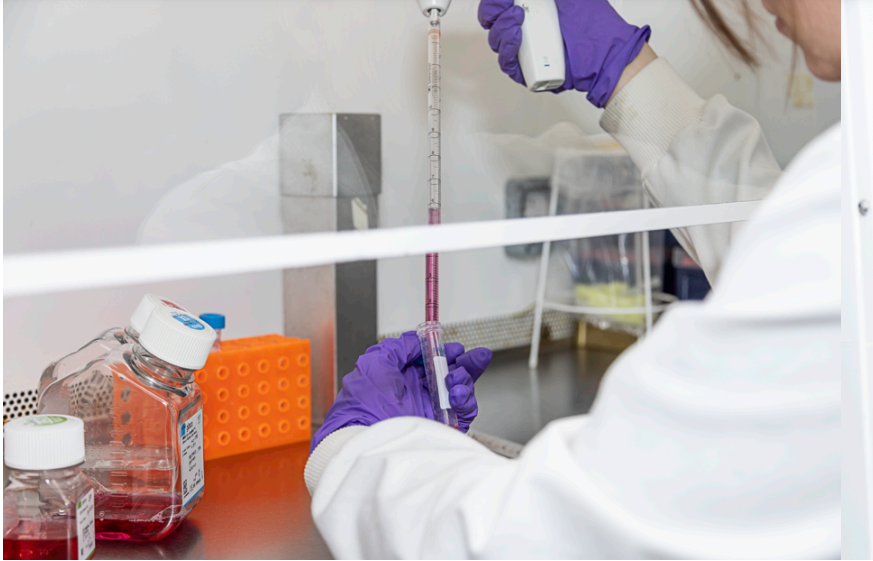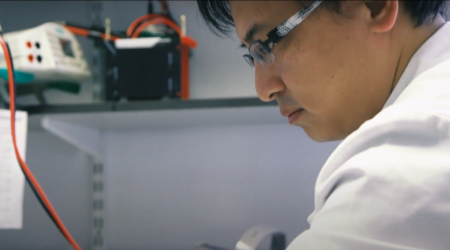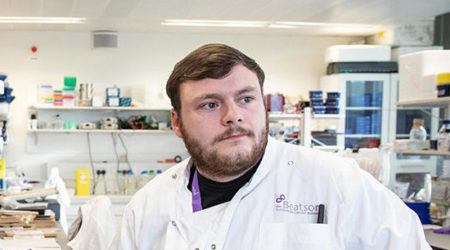

Early Detection Innovation Projects
With the funds raised by our incredible supporters, we’re investing in five innovative new early diagnosis projects alongside Cancer Research UK and the Engineering and Physical Sciences Research Council (EPSRC).
Read all about our research projects
- Early Detection Innovation Projects
- Future Leaders Academy
- The Pancreatic Cancer UK Grand Challenge
- Research Innovation Fund
- Clinical Pioneer Awards
- Career Foundation Fellowships
At Pancreatic Cancer UK we are committed to funding vital research into early diagnosis, bringing together the best scientists and experts in the field. Pancreatic cancer is a disease with unacceptably low survival rates so we want to make sure change happens, faster.
Our latest investment is no exception. With the funds raised by our incredible supporters, we’re investing in five innovative new projects alongside Cancer Research UK and the Engineering and Physical Sciences Research Council (EPSRC). Together, we’re investing up to £600,000.


These projects were selected after a series of virtual workshops that took place in 2020. The workshops brought together pancreatic cancer scientists with specialists in other types of cancer, as well as leading figures from different backgrounds and fields of research, like engineering and mathematics and experts in AI (Artificial Intelligence). It gave them the opportunity to collaborate and think differently, bringing in approaches from different sectors to find new, innovative ways of detecting pancreatic cancer earlier.
As a result, the projects we’re funding are incredibly diverse and exciting, and being delivered by completely unique groups of researchers, testing truly cutting-edge scientific approaches and tools never before used in the detection of pancreatic cancer. These include using AI to determine people’s risk of pancreatic cancer and using nanotechnology combined with MRI to improving detection of the disease.
We hope to contribute to the creation of an effective and accurate biomarker test for pancreatic cancer, which can be easily implemented into today’s healthcare system.
We’d not be able to make this investment without our incredible supporters, so thank you so much.
Here’s some more detail on these exciting projects
Using AI to identify patients most at risk of developing deadly tumours
The team behind this research hope to repeat the successes of a game-changing Artificial Intelligence (AI) prediction system called a Generative Adversarial Network (GAN) in pancreatic cancer research.
Understanding and analysing vast patient data is key to finding people most at risk of pancreatic cancer and who require further investigation.
By combining complex data containing information such as symptoms, demographics, medical history, scans and lifestyle factors, the team will train an AI model to identify a patient’s risk of developing a deadly tumour in the future. The algorithm will generate and prove reasonable theories, patterns and regularities from this data, something which clinicians or even current computer systems are unable to do. This will help to identify how a pancreatic cyst might develop in the future, and what crucial factors might be in play to transform it from benign to malignant.
Collaboration between: computer scientist, pancreatic cancer surgeon, medical imaging scientist, computational and mathematics expert and statistician.
“We hope the theories that the algorithm generates will create a key decision-making tool to help diagnose pancreatic cancer earlier.”
Dr Ardhendu Behera, Edge Hill University
Using patient data and infrared spectroscopy to determine pancreatic cancer risk
After successfully using new technologies to find early stage brain cancer in patients, this team of researchers hope to do the same with pancreatic cancer. They will use a cutting-edge technology they’ve started to develop called infrared spectroscopy. This will be alongside studying the immune cells in a patient’s blood and key clinical and demographic data to detect cancer earlier.
Currently, there are no screening programmes to identify people with a high risk of pancreatic cancer.
The complex combination of tools that this project sets out to use will analyse blood and urine samples of those with pancreatic cancer, and those without a diagnosis but who are experiencing symptoms, to understand the patterns and similarities. From this, the team hopes to create a tool for health professionals to help them easily identify and prioritise those who require further rapid diagnostic testing, transforming pancreatic cancer survival rates.
The work will also feed into larger studies aiming to first identify people at a higher risk of developing deadly PDAC tumours within the next 5 years.
Collaboration between: pancreatic cancer researcher, data scientist, neurosurgeon, pancreatic cancer researcher, cancer epidemiologist, data scientist and computer scientist.
“The decision making tool devised from this study has the potential to transform how we detect pancreatic cancer, particularly if we are successful in identifying key changes in urine samples. Not only could this be a low-cost solution, but also a very accessible way of identifying high risk individuals, with the potential of increasing both the accuracy and efficiency of patient referrals for further testing.”
Dr Pilar Acedo, University College London
Measuring light emitted from chemical reactions in pancreatic cyst fluid to detect those at risk of becoming cancerous
This team of researchers will be using special electro-sensors called ‘optrodes’ to detect if two substances (Hydrogen peroxide and mucin) are present in a range of pancreatic cyst samples. These two substances have been shown to be involved in the development and growth of pancreatic cancer. They will be able to assess the levels of them in the samples and determine if they can be used as indicators (biomarkers) of cysts at high risk of developing into pancreatic cancer.
Pancreatic lesions (or cysts) are sacs of fluid that can develop into pancreatic cancer. New and more accurate methods of identifying cysts at high risk of becoming cancerous are desperately needed to help diagnose and treat patients as early as possible. If successful, the team will have confirmed two potential biomarkers to detect pancreatic cancer at an early stage.
Further to their study, the team hope to make this device small enough to combine with an endoscope (an instrument used to look at organs in your body), so they can analyse these substances quickly and effectively from inside someone’s pancreas.
Collaboration between: chemical engineer, medical imaging engineer, pancreatic cancer researcher and pancreatic cancer surgeon.
“If we are successful, this would be the first time a cutting-edge detection device will be used to detect pancreatic cancer from within someone’s body; an incredibly exciting prospect for the future of cancer diagnostics.”
Dr Paolo Bertoncello, Swansea University
Using nanoparticles to enhance the accuracy of MRI scans to identify cancers at the earliest stage
This group of researchers are using and combining three key techniques to make MRIs more effective at detecting cancer earlier using:
- ground-breaking nanotechnology, they will use a special dye made up of nanoparticles, which will attach itself to pancreatic cancer cells and be picked up by MRI scans
- super-resolution reconstruction to make the imagery created by MRI scans more detailed, giving doctors the best possible chance of detecting small tumours
- MRI fingerprinting, the team will increase the information they get from an MRI, including the quantities of specific chemicals that can be critical clues to identify pancreatic cancer.
MRI and CT scans that are currently used to identify pancreatic cancer struggle to detect cancers smaller than 2cm, by which time there is a high chance that the cancerous cells have spread around the body.
Collaboration between: radiologist, chemist, pancreatic cancer surgeon, pancreatic cancer researchers, health economist and computer scientist
“This research could have the potential to completely transform how medical professionals use MRI to detect pancreatic cancer, and ensure that tumours are picked up at the very earliest stage. At the moment, more than half of all people diagnosed with pancreatic cancer are already at stage 4, where one-year survival is less than 10%, so this is an incredibly exciting prospect for pancreatic cancer.”
Dr Clare Hoskins, University of Strathclyde
Detecting the presence of VOCs to identify pancreatic cancer
The team behind this project will build on exciting research of small molecules called volatile organic compounds (VOCs), gaining a better understanding of their presence in the body, how they are produced and where more are found when pancreatic cancer is present. Finding out how and where they are best detected will be key to creating the most effective way to make this into a biomarker test for pancreatic cancer.
Previous studies have suggested that VOCs could be considered as unique and novel cancer biomarkers, particularly for cancers like pancreatic that are very difficult to detect. These small molecules are produced in the body both by cancer cells and bacteria living in the gut and can potentially be detected in blood and urine samples. The work presents an exciting opportunity to develop a non-invasive method of early detection for pancreatic cancer, which is so desperately needed.
Collaboration between: early detection researcher, pancreatic cancer researcher, industrial analyst and biochemist.
“We hope to contribute to the creation of an effective and accurate biomarker test for pancreatic cancer, which can be easily implemented into today’s healthcare system. This could take the form of a blood test, a urine test or even a non-invasive breath test, depending on what brings the best results.”
Dr Piers Boshier, Imperial College London




